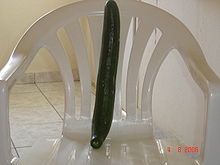| Revision as of 09:22, 8 September 2004 view sourceBobblewik (talk | contribs)66,026 editsm Units← Previous edit | Revision as of 17:47, 2 October 2004 view source Robbot (talk | contribs)94,607 editsm Andre Engels - robot Adding:heNext edit → | ||
| Line 43: | Line 43: | ||
| '''Cucumberer''' is an Internet game similar to ]. It is accessible at , with "gurka" being swedish for "cucumber". | '''Cucumberer''' is an Internet game similar to ]. It is accessible at , with "gurka" being swedish for "cucumber". | ||
| ⚫ | ] | ||
| ] | ] | ||
| ] |
] | ||
| ] | ] | ||
| ] | ] | ||
| ] | |||
| ] | ] | ||
| ] | |||
| ] | ] | ||
| ] | ] | ||
| ] | |||
| ] | ] | ||
| ⚫ | ] | ||
Revision as of 17:47, 2 October 2004
| Garden cucumber | ||||||||||||||
|---|---|---|---|---|---|---|---|---|---|---|---|---|---|---|
| Scientific classification | ||||||||||||||
| ||||||||||||||
| Binomial nomenclature | ||||||||||||||
| Cucumis sativus | ||||||||||||||
| Ref: ITIS 22364 |
The cucumber is the edible fruit of the cucumber plant Cucumis sativus, which belongs to the gourd family Cucurbitaceae, as do melons and squash. The plant has been cultivated for 3000 years and is widely cultivated today. The cucumber plant has large leaves that form a canopy over the fruit. The vine is grown on the ground or on trellises, often in greenhouses.
The fruit, which is a vegetable in the culinary sense, is commonly harvested while still green and is eaten raw or cooked or is made into pickles. Cucumbers have only small amounts of nutrients. Pickles are more nutritious than fresh cucumbers because of the ingredients, especially dill, added during pickling.

Cucumbers are usually green-skinned, roughly cylindrical, elongated, with tapered ends, and may be as large as 30 cm long and 5 cm in diameter. Cucumbers grown to be eaten fresh (called slicers) and those intended for pickling (called picklers) are similar. Slicers grown commercially for the U.S. market are generally longer, smoother, more uniform in color, and have a tougher skin. Slicers in other countries are smaller and have a thinner, more delicate skin. Picklers are generally shorter and thicker.
A few varieties of cucumber are parthenocarpic, the blossoms creating seedless fruit without pollination. Pollination for these varieties degrades the quality. In the US, these are usually grown in greenhouses, where bees are excluded. In Europe, they are grown outdoors in some regions, and bees are excluded from these areas. Most cuke varieties however, are seeded and require pollination. Thousands of hives of bees are annually carried to cucumber fields just before bloom for the purpose. Symptoms of inadequate pollination include fruit abortion and misshapen fruit.
Traditional varieties produce male blossoms first, then female, in about equivalent numbers. New gynoecious hybrid cultivars produce almost all female blossoms. However, since these varieties do not provide pollen, they must have interplanted a pollenizer variety and the number of beehives per unit area is increased. Insecticide applications for insect pests must be done very carefully to avoid killing off the insect pollinators.
Cucumbers are used in the decorative food art, garde manger.
External links:
- Plant profile at the Plants Database (http://plants.usda.gov/) - shows classification and distribution by US state.
Cucumberer is an Internet game similar to Outwar. It is accessible at www.gurka.se, with "gurka" being swedish for "cucumber".